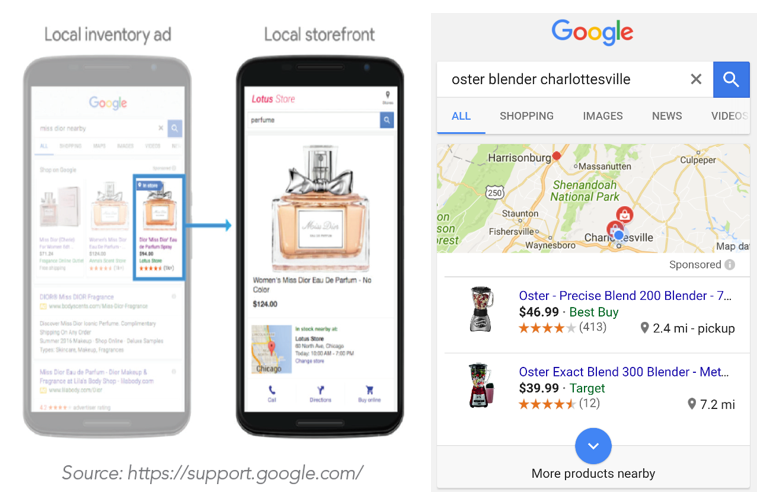When should advertisers consider pausing Google Local Inventory Ads?

Retailers that sell online and in-store need to balance where to send users in their paid search efforts. Columnist Andy Taylor explores when advertisers might want to rely on local inventory versus regular product listing ads.
In response to the growing popularity of searches with local intent, Google released Local Inventory Ads (LIA) a few years ago as a variation of Product Listing Ads (PLA) that include information on when a product is available at a nearby store location. Taking into account the local intent of each search query in determining when LIAs should be featured, Google can serve these units in a similar format to traditional PLAs, as well as in other LIA-specific formats, such as beneath a Google Maps display.
These units are steadily becoming an important part of paid search campaigns for brands with brick-and-mortar locations, and LIA traffic increased 60 percent Y/Y in Q3 2016 for the median Merkle retailer. However, there are several situations in which advertisers may want to consider pausing LIAs, though such scenarios are all complicated and do not necessitate that LIAs be paused.
1. When store locations are closed
This might seem like an obvious practice, but the decision to pause campaigns when stores are closed should come with some consideration of the longer-term impact, since users might be looking to pick a product up at a later date. However, users might also be more likely to convert online when purchasing an item that they don’t need the same day, particularly with brands that provide free shipping.
Regardless, in the event that store locations are closed in recognition of a holiday or for other reasons that change typical weekly hours, advertisers might consider pausing LIAs.
2. When online deals are better than in-store prices
Some retailers run online promotions which do not apply to in-store purchases, making online prices more attractive to searchers. During such promotions, it might make sense to turn LIAs off in order to ensure that searchers see the best deal featured on the SERP.
3. If in-store inventory is running low
In circumstances where advertisers feel confident that they’ll move all of the inventory at a store location without LIAs, it may make sense to pause LIAs. Obviously, it’s impossible to say whether a store will be able to sell all of its inventory of every product in its feed, but specific products could be removed from the local feeds used to power LIAs in order to prevent LIAs from featuring those products that will likely sell out. This wouldn’t technically count as “pausing” LIAs, but it’s an interesting consideration nonetheless.
Why advertisers might not want to pause LIAs even in these circumstances
Those are some situations in which it might make sense to consider turning off LIAs for a period of time, though certainly there could be other instances as well. However, there’s also reason to leave them running even in these cases.
Perhaps the most important one is that it’s becoming common for Google to feature all LIAs and no PLAs for searches that indicate local intent.
For these searches, brands which don’t have active LIAs stand little chance of getting ad impressions and might be better off continuing to show LIAs, even if there are reservations such as those mentioned earlier. Most advertisers would rather reach an audience at a potentially less valuable time than not reach the audience at all.
And echoing an earlier point, there’s also the possibility that users might come to the store location at a later date, or that they’d prefer to visit a store even if there is a better deal online, making any temporary issues such as store closure or better online prices less of a concern.
Conclusion
Searches with local intent are growing, and the success of Product Listing Ads (which accounted for 48 percent of all Google paid search clicks for Merkle retailers in Q4) has shown how popular image-based product ads are with searchers. As such, Local Inventory Ads are a no-brainer for both Google and retailers with brick-and-mortar stores in terms of providing searchers with the information they need to head to a store location.
However, the question of whether LIAs drive more value for advertisers than traditional PLAs is complicated. Aside from questions of stores being open, inventory considerations and ensuring users are presented with the best deal, there’s a larger question involving the trade-off between driving in-store transactions and reducing website purchases.
While Google has made significant strides towards providing advertisers with measures of the offline value driven by online ads through in-store visit and transaction tracking, these and other methods of measuring offline interactions are still imperfect and reliant on extrapolating the tracked set of users to estimate the actions of all searchers (since there’s simply no way to track the entire search population… yet). Given that LIA campaigns have lower online conversion rates than traditional PLAs, assessing profitability of these ad units and setting appropriate bids hinges on measuring the expected offline value of clicks.
Thus, advertisers are still evolving how they view Local Inventory Ads and what KPIs to shoot for given the tracking available. Some use visibility metrics such as impression share targets, while others maintain the same return on ad spend goals as traditional PLAs and attempt to bake in the offline value driven by LIAs. Given these different types of goals, strategies regarding when LIAs might be paused in order to show traditional PLAs also vary from advertiser to advertiser.
The debate on whether to push users to a store location or shepherd them to a website will be an important one moving forward. Brands with brick-and-mortar stores are starting to tackle that debate as it pertains to LIAs and are finding circumstances in which they’d prefer searchers end up on the website.




